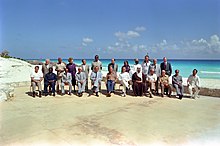Austria–Mexico relations
 | |
Austria |
Mexico |
|---|---|
Austria–Mexico relations refers to the diplomatic relations between Austria and Mexico. Both nations are members of the Organisation for Economic Co-operation and Development and the United Nations.
History

In July 1842, the Austrian Empire and Mexico established diplomatic relations after signing a treaty of Friendship, Navigation and Commerce between the two nations.[1] In December 1861, Emperor Napoleon III of France invaded Mexico. After successfully taking over the country, Emperor Napoleon III, along with the Mexican aristocracy, offered the crown of Mexico to his Austrian cousin, Maximilian of Habsburg. In April 1864, Maximilian, along with his wife Carlota set sail for Mexico and upon arrival to the country in May 1864, Maximilian was declared Emperor of Mexico. This period was known as the Second Mexican Empire.[2]
The reign of Emperor Maximilian was engulfed in constant conflict between his French backed government and the government in exile of Benito Juárez. In 1866, France withdrew its army from Mexico and in June 1867, Emperor Maximilian was captured by Juárez forces in Querétaro City and executed along with two of his generals, thus ending the empire.[3] After the execution of Maximilian, diplomatic relations between Austria and Mexico were severed until 1901.[4]
In 1938, Mexico became the only country to protest against the anschluss of Austria at the League of Nations.[5] During World War II, Austria was part of the German Reich and in May 1942 Mexico declared war on Germany after the destruction of two Mexican oil tankers in the Gulf of Mexico by German U-boats.[6] After the war, normal relations were restored between the two nations.

Over the years, diplomatic relations between the two nations have strengthened. In 2005, President Heinz Fischer became the first Austrian head of state to pay a visit to Mexico.[7] In 2006, former President Vicente Fox reciprocated the visit by paying a state visit to Austria.[8] Over the years, there has been much discussion between the two nations over whether Austria should return to Mexico Moctezuma's headdress and various other pre-Hispanic artifacts that were removed from Mexico in 1519 were taken to Austria where they are on display at the Museum of Ethnology in Vienna.[9] In July 2014, it was declared that the headdress was too fragile to travel and therefore cannot be returned to Mexico.[10]
Trade relations

In 1997, Mexico and the European Union (which includes Austria) signed a free trade agreement. In 2014, two-way trade between both nations amounted to $1.19 billion USD.[11][12] Austria is Mexico's 36th biggest foreign direct investor. Between 1999 - 2012, Austrian companies invested over $135 million USD in Mexico. During the same time period, Mexican companies invested $210 million USD in Austria.[12] Mexico's main exports to Austria include: machinery, electronics, car parts and beer. Austria's main exports to Mexico include: pharmaceutical products, steel, aluminum and paper.[12]
Resident diplomatic missions
- Austria has an embassy in Mexico City.[13]
- Mexico has an embassy in Vienna.[14]
See also
References
- ^ Diplomatic relations between Mexico and Austria, Slovakia and Slovenia (in Spanish)
- ^ Emperor Maximilian of Mexico
- ^ Maximiliano de Habsburgo (in Spanish)
- ^ Relaciones bilaterales México - Austria (in Spanish) Archived March 17, 2014, at the Wayback Machine
- ^ Joint communiqué by Austria and Mexico on the occasion of the 70th anniversary of the Mexican protest against the "Anschluss" of Austria by Nazi Germany
- ^ Historia de la diplomacia entre México y Alemania (in Spanish)
- ^ Bundespräsident Heinz Fischer bei Wirtschaftsforum in Mexiko (in German)
- ^ Inicia Fox formalmente visita de Estado a Austria (in Spanish)[permanent dead link]
- ^ Mexico inches closer to loan of Moctezuma’s headdress
- ^ El frágil penacho de Moctezuma (in Spanish)
- ^ Mexican Ministry of the Economy: Austria (in Spanish)
- ^ a b c Comercio bilateral entre México y Austria (in Spanish) Archived March 17, 2014, at the Wayback Machine
- ^ Embassy of Austria in Mexico City (in German and Spanish)
- ^ Embassy of Mexico in Vienna (in German and Spanish)


